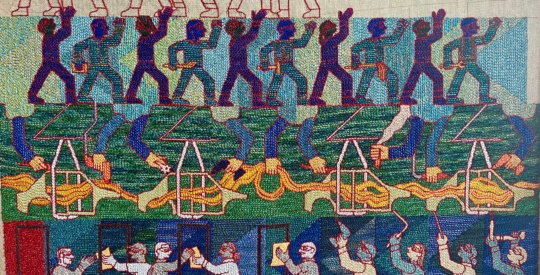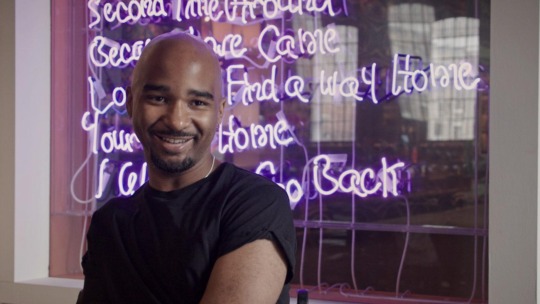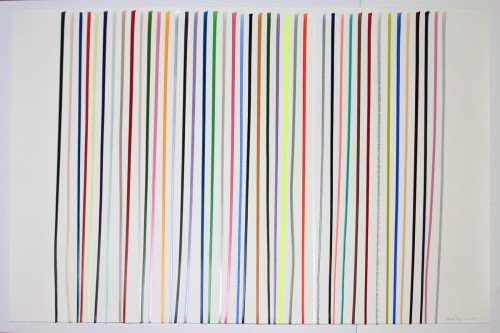
Scott Ingram’s current solo show at Emily Amy Gallery, Cusp, continues his twelve-year long series of nail polish paintings. Ingram has used the medium to take the aesthetics of mid-century painters such as Ellsworth Kelly and Morris Louis into a humorous pop-cultural context that explores how painting can still be relevant. I spoke with Ingram about the evolution of the series during his installation at the gallery.
Susannah Darrow: You have done the nail polish series before. Is this series a reinvestigation or a continuation? What is happening with this series now?
Scott Ingram: I’ve never actually stopped making them. I’ve been making them consistently for almost 12 years. They really started out as very formulaic: there were specific paper sizes, papers, textures of the paper; it was very specific. It was all based on Arches watercolor paper; they were specific to the sizes. The only way I could deviate from that was to tear the paper into quarters. There were basically four sizes in the beginning and there was nothing on canvas. If it needed to be bigger it was an assemblage of papers; it was modular. There had to be rules to it, because without rules you could go anywhere, and at the time I wasn’t sure I wanted to go anywhere with it. I really made very rigid and stringent rules because I didn’t want it to rule my life, and once I first saw how it worked I knew it could if I let it.
A couple of years ago, I thought, you know the wall drawings are really great, but that’s not part of the formula. So, I really needed to change and develop new sizes and new ideas for it. For Nancy Solomon’s show at Solomon Projects it was still very rigid with the sizes, but they were all big with the exception of the wall drawing. Then I did the Contemporary’s and Spa Sentio’s wall drawings and was like, “I’ve completely screwed up the formula.” Once I let the cow out of the gate it was done. So now there are no rules.
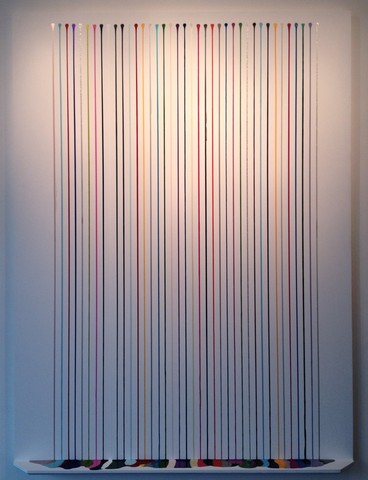
SD: It sounds like when you first started it was very analytical in terms of color choice, sizing, paper—all the components. Is it still an analytical process or is it more intuitive now?
SI: The funny thing is now there is even more thought that goes into it, and the planning is even greater and longer. I am actually doing color-pencil studies for them now. I don’t want to make the same piece over and over again. Even changing the colors isn’t enough for me. You can have the bright colors and do the same scheme and composition, but even if it’s darker colors, it’s just the same piece in darker colors, which isn’t that exciting to me. The challenge is making a different piece every time. A lot of them are very similar, and that just happens. And part of it is a combination of finding things that I like in them and the experience of making them and wanting that experience to happen again when restarting the whole process.
SD: As you go through the show, the repetition of shape and composition forces you to pay attention to the subtleties of how you adjust each painting. The aesthetic seems to marry minimalism with color theory.
SI: Ultimately, they are based in themes and ideas of minimalism, but they are not minimalist paintings proper; I don’t believe that they fall into that category at all. I am obviously interested in minimalist artists, but if you go back and look at Donald Judd and his writings, the sheer interjection of color alone would exclude mine from being minimalist. They are line drawings, and very simple line drawings; I was thinking more about Gene Davis, Morris Louis, Fred Sandback, and artists like that.

SD: To me, they seem to call to mind the conceptualist tradition that came out of minimalism; artists like Sol LeWitt, who investigated line and mark making and how that changes. There seems to be a similar concept at play in the use of a very set process that allows for an element of chance.
SI: Right. Originally, 12 years ago when I first made them, they were based in Barnett Newman’s Zip paintings. Those were the genesis of this whole process. When I first did the nail polish drawings they only had two lines to them, and it was not about creating lines, but dividing the paper and splitting the space.
SD: Because you have been working on them for such a long time, I think it’s interesting to think about these in relation to your other work. Your other work is also very line based and has a similarly minimalist sensibility to it. Do you think that because this work has been a continual part of your career that it has influenced your other series?
SI:I like line. I like drawing. I like the injection of color too, even in architectural stuff. At the end of it all, my work is based in color, line, and Modernism. And to me, there’s not much difference between this and the architectural stuff. Part of it is the way these use space; the architectural work uses physical space like a wall of a building. I think of the frames as a form of architecture for the work. So when you think about it in those terms, it’s not much different.

SD: I saw your live pour the other day, and outside of laying out where the lines are going to go you don’t have a huge role in how the compositions are going to turn out. You decide what colors begin where, but it’s not necessarily your hand doing that mark making.
SI: I always see drawing in the paintings. For a lot of people there is the issue of how to define what drawing is. For me drawing is simple mark making and there’s no other way to slice it.
SD: Going through the show is very meditative. It sets up a repetitive space. As you do this, is it a similar process, or is it too analytical to be meditative for you?
SI: For the live pour I have everything planned out. I have the colors picked; I have the paper torn to size. Normally, when I do this process I start in the middle and don’t have anything preconceived for what it’s going to look like. There’s a lot of music involved.
SD: What do you listen to when you do these?
SI:Everything. I listen to a lot, so much of what these are depend on what mood I’m in that day. If I’m in a weird, funky mood they might be dark and muddy, and other days they’re a little brighter and happier.
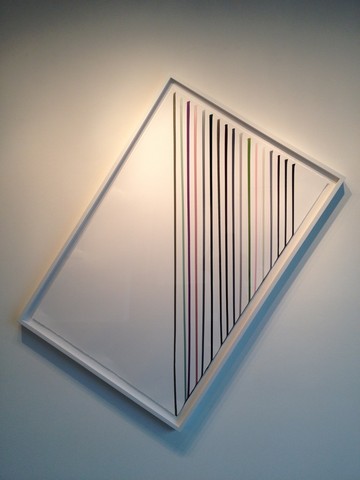
SD: So it is sensory?
SI: Yeah. A lot of it is capturing perception. They’re really about how color affects my mood. I like color a lot, but I don’t subscribe to color theory in any way. I like the way they look next to each other. Taking it back to Barnett Newman and the two zip lines, it’s kind of about filling that space. I still start in the middle and work out. Always.
SD: Is the color choice intuitive as you do them?
SI: I have all the colors there, and I find if I don’t have the color I need, it will sit until I find the color I want. I often go to get polish with a list of colors I’m interested in. I’ll write down “muddy green” with a reference to an object that’s in my head that is that color, so that when I get to the store and find the color, I know what it’s for and where it came from in the process.
SD: You use the names of the nail polish for the titles. Does that influence the mood of the work?
SI: It’s not titled until I finish. I used to go through all the polishes and find a name I liked and name it that way. It gave a sense of randomness to it that I really liked. There was always something that resonated too. There’s the sense of a found object to that process that I really like as well. I’ve had so much trouble finding good titles lately that I’ve started to sample them. I may pull words out of different ones and sandwich the two.
SD: You have been doing this for such a long time. How do you keep it relevant?
SI: Personally, I don’t feel like I have exhausted it. Over the last 12 years I would do a show and then I’d make them on a commission basis, but I was interested in other things at the same time. Right now I have some diamond pieces I want to do. They are going in new directions. It keeps me interested.
Scott Ingram’s exhibition of nail polish drawings, Cusp, will remain up at Emily Amy Gallery through January 28, 2012.


